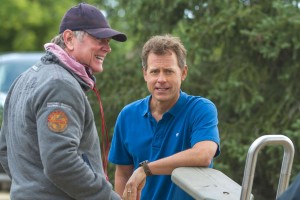
Interview with Greg Kinnear: Heaven is for Real, A Nebraska Family’s Experience
On April 9, 2014, Greg Kinnear and I met for an interview at Chicago’s Park Hyatt Hotel in a suite with a fabulous view of the Chicago River. Immediately, he was charming, funny and easy-going. I’ve admired his acting since his Academy Award nominated performance in As Good as it Gets (1997). He wore a long sleeve navy polo shirt with off-white relaxed fit slacks and New Balance tennis shoes. A regular guy for sure. He has a light shade of cobalt blue eyes and a contagious smile. Our interview time flew by in the blink of a (cobalt blue) eye. We chatted about his Alma Mater, the University of Arizona afterwards, of which he continues to visit.
Sarah Knight Adamson: Greg Kinnear, thank you so much for chatting with me today. I want to say congratulations on your performance in the film Heaven Is for Real. I thought you were absolutely tremendous in the role of Todd Burpo. What drew you to this role?
Greg Kinnear: It was probably Randy Wallace; he certainly was the first inkling that may be something was of interest here. I worked with him on We Were Soldiers (2002) and had a really had a great experience. He’s an excellent writer and director. He asked me if I’d heard of the book (of the same name). I had not [heard of the book] so he told me the story. I thought he had really found a very open and accessible story here with this family and what they went through with their little boy.
SKA:Yes. Connor Corum who plays your son, Colton, gives an amazing performance as well. My favorite scene is when you’re on the seesaw with him, and he’s telling you about heaven. He’s just so natural. Could you tell us a little bit about what it was like working with a five-year-old, I believe?
GK: Yeah, five years old playing four years old. He hadn’t done any film work when he was cast. He’s not from Hollywood. He’s not a child actor. He was really kind of found by accident and was one of the last boys that we looked at. They conducted a national search and then kind of narrowed it down, and I read with some kids. There were a lot of good choices. But Connor was leaps and bounds above the other choices, just in terms of his expression of complete honesty, truthfulness and vulnerability.
He just had this innocence that you can’t act, I don’t think. It inherently has to be in you and he had it. We were able to use it in the movie in really powerful ways.
SKA: Sure, sure. He seems to be a very bright little boy. He appears so on screen.
GK: Well, he’s ordinary and he’s…honestly, (pause) that’s a good question. He may be the next Einstein. I just have no idea. I mean, he’s certainly not unique in the sense that he’s just all boy. When the camera isn’t rolling, he wants to go throw the baseball with me or kick the soccer ball and get his Spider-Man dolls. Then, periodically, he knows he has to go and do that thing that all 150 people surround him for and look nervously on as he does. Then, he goes back to being a kid.
But I suppose there’s an undeniable intelligence there that kind of comes through in the performance. Just the fact that he’s able to negotiate that, to be able to be a kid in his first movie and then take on the huge responsibility of knowing when he needs to be there to deliver what’s in the movie.
SKA: Sure. You know another reason I like that seesaw scene (above photo) so much is because of the clouds and the sky – especially when you’re talking about heaven because as you are it’s like wait, there’s heaven in the sky. The movie cinematically is just so beautiful. Do you have a favorite scene?
GK: Well, there are some aerial footage and some driving scenes that are pretty breathtaking. We hit this little window in Winnipeg and when I tell you they have a little window, I’m not lying. It’s a tight summer in Winnipeg, and we caught it beautifully, and the weather was very favorable. I mean, there was one day where I thought it was going to snow in August, but other than that, it was really glorious. Dean Semler who worked with Randy and I on We Were Soldiers is excellent. He shot Dances with Wolves and he’s just an extraordinary guy behind the camera. He really captured the land and what is Imperial, Nebraska, in a way where it’s a character in the movie. It doesn’t surprise me that you pick up on that because I thought so, too. I thought it was absolutely beautiful and certainly a love letter to the city of Winnipeg.
SKA: Well, I actually went to high school for a couple years in Scottsbluff, Nebraska near Imperial. So, it’s very close and it’s so realistic. I mean, I’m like, “I’m back home here.”
SKA: I thought the chemistry between you and Kelly Reilly, who plays your wife Sonja, was really spot-on. Your emotional scenes together were really powerful. Did you draw on your own family? I know you have a family. It’s very realistic, Greg, very realistic.
GK: Well, I’ve got to be careful here.
SKA: I know.
GK: Don’t want to get in trouble with the wife.
SKA: No. No way!
GK: Caution.
SKA: Yes.
GK: Spoiler alert here. Well, you know, I had seen Kelly’s work in Robert Zemeckis’s Flight (2012) and I thought she was amazing. She’s a tremendous actress. When I was cast in the movie I didn’t know who was going to play the role of Sonja. Randy called me one evening after having dinner and a margarita with Kelly and said, “Greg, I just met your wife.”
SKA: Oh, that’s great. (Both laughing.)
GK: He was just jumping with enthusiasm. He just knew this was going to work, and it really did. I wish I could say it was a lot more acting than it was to create a sense of fondness between us but it was great. I love her. I really do. I’ll tell you something. It was an important aspect to the movie because usually when you see a minister, a preacher, they’re wearing robes and carrying candles, that’s just what they do.
Todd Burpo, is a multidimensional guy. He’s a volunteer firefighter. He’s a volunteer wrestling coach at the high school. He installs garage doors. He’s a parent. Oh yes, he’s a pastor too. The fact that he loves his wife deeply was a really cool element that I hadn’t seen in a movie. I was like like,
”Oh, wow, there’s allowed to be a strong, loving, real relationship between a man and woman in spite of the fact that he goes to a pulpit as a part-time job. I hadn’t seen that before and I thought it was cool.
SKA: Oh, I certainly did too, and I appreciated that aspect of the family life. I raised three children of my own and I can identify with those emotional scenes, particularly the hospital scenes. When you are together and then you’re apart and you’re trying to sort through this scenario of maybe losing a child and then what happens after, I mean, it’s just really great. It shows on screen, I believe. It’s really true.
GK: Thank you.
SKA: What type of viewers do you think will want to see this film?
GK: Well, I think there’s probably some segment of the audience, given its title and subject matter who will instantly say, “Check, please. No interest.” That’s all right. I think there certainly is a group that isn’t going to be open to that. I think there’s obviously a group who are very fond of that book. It was on the New York Times Bestseller list for a hundred-plus weeks for a reason. It’s sold millions and millions of copies and it connected with an audience in a big way.
I think the movie is respectful to the book, and I think those people will be happy. But the audience ? It’s a great question because the audience that I hope is open to it or might discover it is that kind of middle audience of … maybe they don’t know. Maybe they don’t have it all figured out, one way or the other. They may be open to the search, open to ideas and open to questions. They might watch it and it may resonate in some way where they can at least have some discussion with themselves about where they’re at with that.
It is an interesting question. It’s the fundamental question, of course, of your life. Is there anything after? Is there not? Anything for somebody who is open to that… who can watch a piece of art and have it inspire some questions..I don’t think it’s a bad thing. The movie doesn’t get dogmatic, in my opinion. It’s not preachy. I don’t feel like the film is insistent on the viewer taking a position. I don’t think it says, “This is what you should believe.” It tells you with great clarity what happened to this family.
SKA: Sure.
GK: You can accept that or not accept that. Regardless of where you’re at on the spiritual spectrum, I still think there’s an entertaining movie here. That was probably the top of the list.
SKA: Oh, yeah.
GK: I hate it to be a sermon.
SKA: Yeah. It’s not at all, I don’t believe.
GK: Yeah.
SKA: Last question. Working on such a film… did it affect your own beliefs at all?
GK: Probably. I mean, it affected them in the way that I believe strongly that the events, as we tell them in our story, is probably how it happened to the Burpo family. That’s no small thing. I mean, it’s a pretty extraordinary story for a family to tell. There are issues within it that are bigger questions than I want to deal with in sound bites.
But I do think that we got that part of the job right, which was for all of us to try to allow you as an audience to experience the events as they’ve been told in the book.
SKA: Well, I want to thank you so much for chatting with me. Best of luck with the film.
GK: Thank you. Thank you very much.
Sarah Knight Adamson ©April 15, 2014
